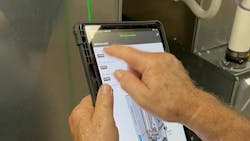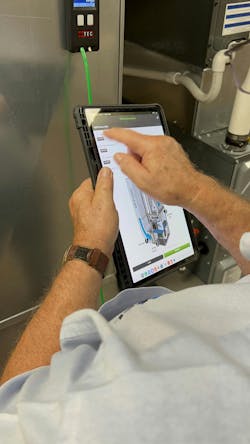Create Air Upgrade™ Leads with Static Pressure Testing
PART 2 of a 6-PART SERIES
In last month’s article, we looked at a way to enhance your product offerings with pre-packaged, flat rate duct repairs called the Air Upgrade™. This unique product is a simple solution to many airflow problems that cause costly callbacks and unhappy customers. The challenge is finding a quick and easy way to help a homeowner “see” any airside defects their HVAC system could have.
Static pressure testing is one piece of the solution. The test results help a homeowner understand the state of their HVAC system’s overall health. These measurements set the stage for Air Upgrades. Unless you measure static pressure, Air Upgrade opportunities remain hidden.
While I’ve written many articles on static pressure measurement in the past, this piece ties in specifically with the Air Upgrade process. Some of what follows are foundational principles that never change, while other content is process specific. Let’s look at how to measure static pressure to create Air Upgrade leads.
Assemble a Static Pressure Test Kit
Before you can take static pressure measurements, you need test equipment. Many technicians and salespeople have bits and pieces of what they need, but it’s often scattered and rarely easy to find. Since this test equipment plays such an important role in the Air Upgrade process, make sure you have it in one location. Here’s what you’ll need:
Regarding testing equipment: the goal is to start with what you already have for immediate success. If you don’t own any of these items, invest a little more money and purchase the best equipment you can afford.
You can usually assemble a complete kit for less than $250. However, the cost can easily increase if you invest in higher quality manometers like a DG-8 from The Energy Conservatory (TEC) or Bluetooth pressure probes that connect to measureQuick (mQ). The goal is to start with what you already have for immediate success. If you don’t own any of these items, invest a little more money and purchase the best equipment you can afford.
Measure Static Pressure
You typically need four static pressure readings to diagnose a system and identify Air Upgrade opportunities. To access the system’s airside, you must first install static pressure test ports in the system. The type and location of the air-moving equipment determines where to install these ports. Gas furnaces have different locations than an air handler or package unit, so be sure you know the differences.
Once you’ve installed test ports, turn the system to its highest airflow setting. Equipment with permanent split capacitor (PSC) motors will reach full speed quickly. However, equipment with variable speed motors may take more than 10 minutes to reach full speed.
Once the blower has reached full speed, measure:
- Total external static pressure (TESP)
- Filter pressure drop (∆p)
- Coil pressure drop (∆p)
- Supply and return duct pressures.
If you’re recording the readings manually, TESP is the first measurement. It provides an overall picture of what’s happening with the system’s airside. If measured TESP exceeds the air-moving equipment’s maximum-rated TESP, an airflow problem probably exists. Checking pressure drop across the air filter and coil, and testing duct pressures helps you identify which components are most restrictive to airflow.
If you’re using the AirMaxx™ workflows in the mQ or TEC apps, they will guide you through the testing sequence and streamline the data collection process. Just a reminder, there’s no charge to use these apps and they connect to Bluetooth equipped test instruments.
Diagnose Static Pressure Readings
The four pressure measurements each have a diagnostic meaning and identify potential airflow restrictions in a duct system. Compare the pressures you measure against a pressure budget or manufacturer specifications to pinpoint restrictive system components.
The four pressure measurements each have a diagnostic meaning and identify potential airflow restrictions in a duct system.
It can be tough to find manufacturer specifications, so National Comfort Institute (NCI) created pressure budgets to help diagnose static pressure readings. This simple troubleshooting tool assigns a percentage of the equipment’s rated TESP to system components. If you would like a copy of NCI’s static pressure budgets, contact me and I’ll send them to you.
The TEC and mQ apps have variations of NCI static pressure budgets built into them. They do all the calculations for you and generate a third-party report that helps you identify the highest pressure and potential airflow restrictions.
After completing static pressure measurements to identify the most restrictive components to airflow, it’s time to either discuss the results with the customer or hand them off to the appropriate department. We’ll discuss this step next month.
Getting Started
For some companies, adding static pressure measurements to reveal the need for Air Upgrades comes easily. Unfortunately, many others struggle to implement these tests and eventually give up. It’s easy to slip back to doing things the way they’ve always been done. What’s the difference? How does one company succeed while another fails? I’ve seen two ingredients that helped successful companies that unsuccessful companies didn’t have. Those ingredients are a visible plan and consistent tracking.
In successful companies, technicians understood the importance of the measurements and how they tied in with an overall process that was visible to everyone.
In unsuccessful companies, technicians were inconsistent with measurements and were not held accountable for not taking them. In their minds, these technicians heard two words when asked to test: “More work.” Since they didn’t understand the plan, they took readings haphazardly, with no intention of using them. Everyone did their own thing when they felt like it. Again, they didn’t understand the need for taking measurements in the first place.
In successful companies, technicians understood the importance of the measurements and how they tied in with an overall process that was visible to everyone. They understood why they were doing what they were doing and how static pressure readings made their job easier. There was also a place and process for gathering and recording static pressure measurements. As part of the process, techs could not proceed to the next call without static pressure readings. They also knew what would happen with their measurements. Instead of wondering how their efforts would help the company, they knew their work was part of a bigger effort to do top-quality work.
Resistance to change can be tough, so expect to put in the work. Be prepared for push back, but have patience. Your technicians will follow your lead and rise to your level of commitment. If you believe in this process and prove it through your actions, you’ll succeed.
Next Steps
Remember, unless you measure static pressure, Air Upgrade opportunities remain hidden. Test results reveal them, but the next issue is how you communicate those results to help a customer understand the state of their system. Proper communication brings an Air Upgrade to life.
Why not start with your system at home or the one in your office? Take some measurements and see what you discover. Walking through each step of the Air Upgrade process makes it easier to digest and apply.
In the next article, we’ll look at the handoff from tech to comfort advisor or the office and how to discuss test results with a homeowner to gauge the need and desire for Air Upgrades. We’ll also discuss the importance of adding fan airflow to complete the diagnostic assessment needed for an Air Upgrade.
David Richardson serves the HVAC industry as vice president of training for National Comfort Institute, Inc. (NCI). NCI specializes in training that focuses on improving, measuring, and verifying HVAC and Building Performance.
About the Author
David Richardson
Director, technical curriculum
David Richardson serves the HVAC industry as director of technical curriculum at National Comfort Institute, Inc. (NCI), Avon, Ohio. NCI specializes in training that focuses on improving, measuring, and verifying HVAC and Building Performance.

